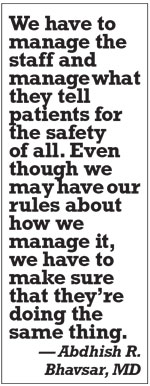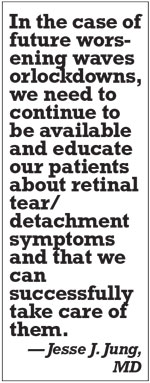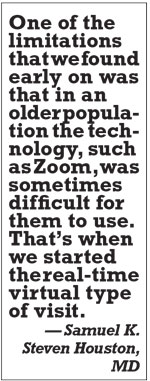The COVID-19 pandemic has had a severe impact on retina practices, with many still recovering. Here, five retina specialists who’ve reported at retina meetings on their experiences in the pandemic and their research into pandemic-influenced trends share their thoughts with Retina Specialist on what lessons should be carried forward if, or when, another wave or pandemic comes around.
 |
Manage the influence of politics
Abdhish R. Bhavsar, MD, is a partner at Retina Consultants of Minnesota.
I underestimated the influence of politics on medicine. I also learned that managing staff is important, which I didn’t quite realize, in the sense that I assumed that everyone would want to wear an N95 mask to protect themselves at the beginning of the pandemic, which we were fortunate to purchase through some creative and nontraditional means, but that wasn’t the case.
 |
In my office—and I’m sure this happened many times—an employee was telling patients that she didn’t want to wear a mask since she didn’t believe in masks and they didn’t work. This was at the very beginning of the pandemic when we’d just obtained the N95 masks at a time when no one, not even surgical practices, could get them. We were thinking we wanted to offer the best protection to our staff. The only reason I found out about what this staff member was saying is because one of the patients the employee was talking to was a scientist who told me about it. Otherwise, I would never have known our own staff were spewing stuff to patients that wasn’t true or scientifically correct. So, I underestimated that.
These are things that all employers have to watch out for in a medical practice. We have to manage the staff and manage what they tell patients for the safety of all. Even though we may have our rules about how we manage it, we have to make sure that they’re doing the same thing.
 |
Educate patients that practices are open
Jesse J. Jung, MD, partner at East Bay Retina Consultants and volunteer faculty at University of California, San Francisco.
We recently presented and published a multicenter collaborative retrospective study through the Young Retina Forum that evaluated the impact the COVID-19 lockdown had on retinal detachment surgeries in the United States, Canada and Mexico.1
The study evaluated 261 eyes, of which 169 were treated through the shelter-at-home orders, during which the American Academy of Ophthalmology and the American Society of Retina Specialists recommended nonessential surgeries be put on hold, but operations for organ-threatening or life-threatening emergencies, such as retinal detachment, should still be done. The study also included 92 eyes treated in the three months after the orders were lifted.
 |
We observed that the patients most likely to have a 22-day delay in seeking care during the shelter-at-home orders were about 3.7 years younger than those who didn’t delay. Additionally, these eyes were more likely to have proliferative vitreoretinopathy and epiretinal membrane post-surgery. Delay in care leads to more of these complicating factors that can result in less ideal outcomes.
At three months after the initial surgery, the study found that single-surgery anatomic success was 85 percent for patients who had surgery during the shelter-at-home period vs. about 75 percent for patients who delayed care, which wasn’t significantly different.
Despite the limitations of the COVID-19 lockdown, vitreoretinal surgeons were still able to care of patients and outcomes were still good, with the final anatomic success still 99 percent. Importantly, this study observed that seeking care for sight-threatening issues, such as retinal detachment, is something that should still be prioritized even in the midst of extreme measures.
In the case of future worsening waves or possible lockdowns, we need to continue to be available and educate our patients about retinal tear/detachment symptoms and that we can successfully take care of them.
 |
Continue the heroism
Paul Hahn, MD, PhD, is a retina specialist at NJ Retina in Teaneck.
In the earliest days of the pandemic, ASRS developed a series of surveys to assess and share the evolving impact of COVID-19 on the retina community.2 Retina practices saw a drastic early decline in patient volume, both internationally and in the United States; more than 80 percent of responding retina specialists reported a more than 50 percent decline volume in March 2020, the date of the first survey. Recovery was slow through July 2020, the date of the last survey, particularly internationally where 70 percent of respondents still reported seeing less than 75 percent of their pre-COVID volume.
These survey results and other data have indicated that telemedicine wasn’t meaningfully adopted by most retina specialists, due to the unique demands of our exam and procedures. Understandably, the survey results indicated significant concern by retina specialists with the vulnerability of the financial health of their practices, but what was more impactful than these financial concerns was the pervasive sense of anxiety, particularly due to the uncertainty of risk to retina specialists. The early days of the pandemic were colored by the COVID-
related death of Wenliang Li, MD, the Wuhan ophthalmologist who was one of the first to recognize this disease.
But the ASRS surveys memorialized a consistent and prevalent current of heroic dedication to put patient care first among all else. Our community of retina specialists should be proud of this heroism.
 |
Minimize patient contact
Samuel K. Steven Houston, MD, is a vitreoretinal specialist at Florida Retina Institute in Orlando:
We thought it would be another five, six or seven years from the beginning of COVID that people would seriously start to utilize telemedicine, but COVID provided a significant push for these technologies. The advances in imaging technologies have allowed us to leverage telemedicine to interact with patients.
 |
Optical coherence tomography technology and ultra-widefield imaging allowed me to minimize exposure time with patients. They give me most of the data points I need to make a diagnosis and treatment plan. They also allow patients to have a quicker throughput. We were starting to update the OCT machines in all our offices before the pandemic. Once COVID hit, we were already set up with these imaging technologies.
COVID was the perfect opportunity for us to roll out a hybrid telemedicine model, as we call it. Regular telemedicine for eye care doesn’t really work that well. We needed to have the imaging. We set up remote test sites where patients just came in, got their imaging, and then left, so, they would only interact with one staff member. They would either connect with me virtually in the office while they were there for their imaging appointment, or connect with me within a day or two to go over the visit.
One of the limitations that we found early on was that in an older population the technology, such as Zoom or any of the other Webex virtual platforms, was sometimes difficult for them to use. That’s when we started the real-time virtual type visit, where patients came in for their imaging and, before they left, they connected with me on the iPad that was in the office. The technician who was there with the patient could troubleshoot any problems if necessary.
 |
Attain uniform messaging
William E. Smiddy, MD, is professor of ophthalmology and the M. Brenn Green Chair in Ophthalmology at Bascom Palmer Eye Institute at the University of Miami Miller School of Medicine.
In our experience, in addition to the background rate of patients lost to follow-up, around 20 percent of patients who get intravitreal injections had a delay in their treatment that was attributable to the pandemic. Common explanations from patients were that they didn’t know we were open or they were afraid to come out and get treatment.
Two things led to this circumstance. Number one is the vulnerability that patients who are on injection-based treatments have to disruptions in their care, such as with COVID-19 or other concurrent medical problems. And number two is we need to have messaging from all levels, whether it’s from federal government agencies, news media, state agencies or even the local news, as to what is urgent care, what is emergent care, and what kind of care is still going to be delivered and what kinds of care isn’t.
The AAO and ASRS were very clear early on in defining the importance of viewing injection-based therapy as urgent, but that message wasn’t universally implemented.
We even had patients who resurfaced, if you will, a year later who thought we were still closed. We never closed. We tried to prioritize and triage the more urgent kinds of patients, such as those who needed surgery or needed injections—patients for whom, if there was an interruption in their care, there was the potential, if not expectation, of a poor prognostic outcome.
Honestly, I was surprised that there wasn’t worsening of vision in more people but, indeed, there were many patients who got worse. Although they improved somewhat, many never really got back to their baseline. RS
REFERENCES
1. Jung JJ, Chang JS, Oellers PR, et al. The Young Retina Forum. Impact of coronavirus disease 2019 restructions on retinal detachment: A multicenter experience. Ophthalmol Retina. Published onine February 7, 2022. doi: org/10.1016/j.oret.2022.02.001
2. Hahn P, Blim JF, Packo K, Jumper JM, Murray T, Awh CC. The impact of COVID-19 on US and international retina specialists, their practices, and their patients. J Vitreoret Dis. 2022;6:40-46



